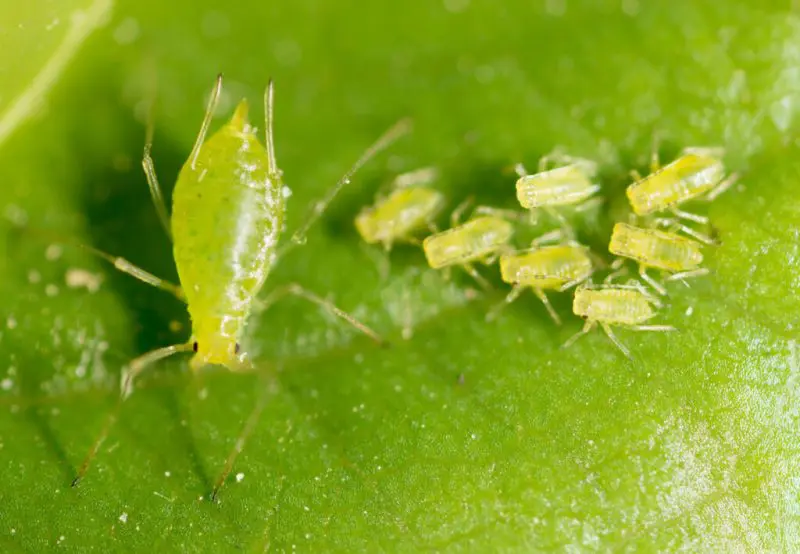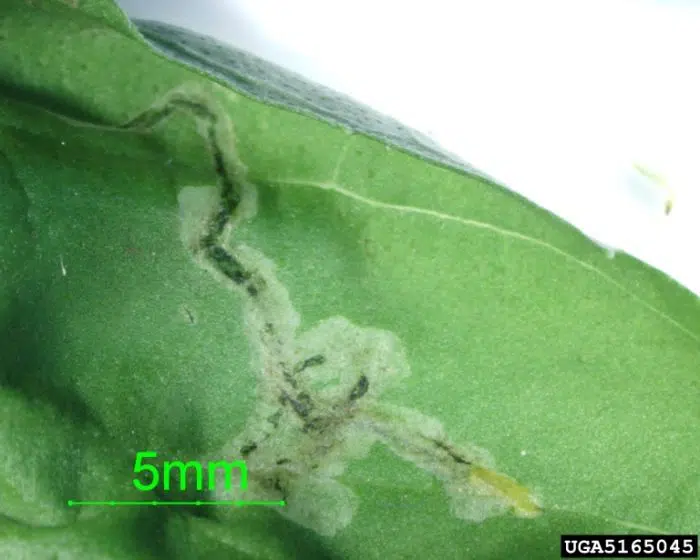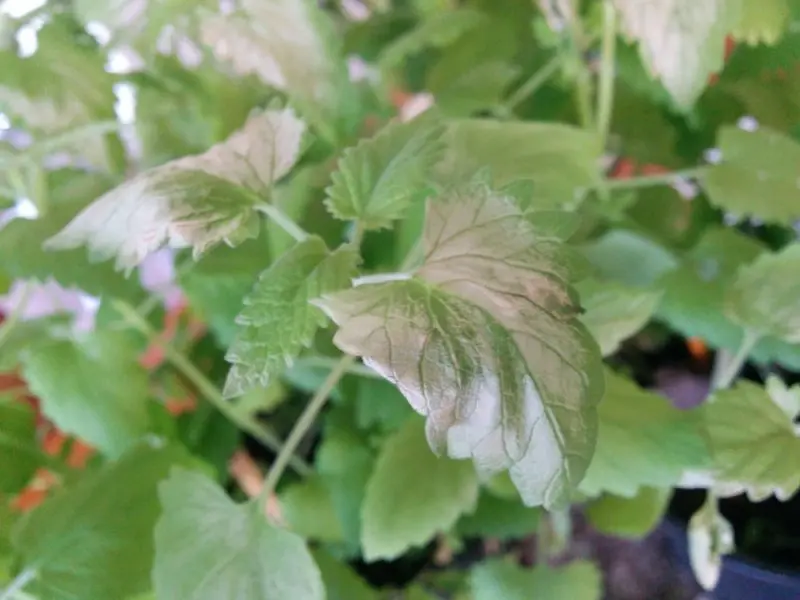A common issue you might come across when growing basil plants is black or discolored spots appearing on the leaves. It may be difficult to identify where these spots come from so they can be properly treated.
Why Are There Black Spots on Basil Leaves?
Black spots on basil leaves can occur for several different reasons. These spots can occur due to a fungal infection, pests or even a lack of nutrients. It is important to have preventative measures in place so that these black spots don’t kill the basil.
Knowing how to prevent these spots from occurring and knowing how to treat them once they show up is important for any basil plant owner.
Pests & Insects
One of the most common reasons for black spots to appear on your basil plant is pests. Some common pests that eat basil leaves are aphids, leaf miners, spider mites, and whiteflies.

Pests aren’t actually eating your plants, they are essentially sucking the sap out of the leaves and stems, this can cause dark spots on your basil plants.
Aphids
Aphids come in all kinds of colors, but most commonly they are green, yellow, and white. They suck the sap out of the plant and can cause black spots on your leaves.
Aphids are very small and can be hard to identify, and they multiply LIKE CRAZY. Plus they leave this gross sticky trail behind called honeydew. You can usually find them on the underside of the leaves, where they lay eggs.
Here are some great ways to get rid of aphids.
Spider Mites
Spider mites are very small and super hard to identify.
They create what looks like little cobwebs on your plants, look like regular cobwebs but they can be very damaging to the basil plant. Spider mites do eat many herbs like basil, so keep an eye out for them.
Whiteflies
Whiteflies also prey on basil by sucking the juice out of the basil leaves and leaving a sticky trail called honeydew. These whiteflies are damaging to basil leaves and can also be repelled with neem oil.
Too much pest damage can cause your plants to put their energy into healing instead of growing, so we want to get these pests remedied as soon as possible.
Leaf Miners

Leafminers feed on the interior of a leaf, creating tunnel-like holes. They do lay eggs in these tunnels, and when those larva emerge, they can cause even more destruction to the plant. Eventually, the damage will turn brown, or even black.
I would get rid of any leaves that have leaf miner damage and not put them in your compost pile, so you don’t accidentally give them more plants to grow on when you use your compost.
Fungal Infections & Disease
Another common explanation for these black spots on basil leaves is due to a fungal infection.
You can identify the fungal infection by looking underneath the leaves as the first signs of trouble (and pests) are underneath the leaves. These fungal infections can occur when the leaves of the plant stay wet for an extended period of time. Basil can turn yellow or brown as well when a fungal infection starts to take place.
To prevent a fungal infection, the following will help:
- Regularly prune your plants – when plants get too bushy they can get overcrowded and won’t allow enough airflow for the plant
- Make sure they get plenty of sunlight – basil, like many other plants, need at least 6-8 hours of direct sunlight.
- Proper watering – watering your plants in the morning rather than evening helps give the leaves and top layer of soil time to dry. If you water them at night, they will stay wet and invite pests and fungal diseases to a great home.
If you do happen to notice graying on a leaf or a black spot, you can still try to save the plant by cutting off the affected leaf or area. Once the infected area is removed, you should treat the rest of the plant with fungicides or with natural anti-fungal methods.
Common bacterial and fungal diseases are basil downy mildew, bacterial or fungal leaf spot, and cercospora leaf spot.
You can prevent these by using copper fungicides and being sure not to overwater your plant.
Lack of Nutrients
Poor nutrition can also be a cause of black spots on basil plants. Basil plants need a decent amount of nutrition in their soil, but they aren’t considered “heavy feeders” like tomatoes are, so this is generally a less common issue. If they are not extracting the nutrients out, then they will be imbalanced and likely develop black or brown spots on their leaves.
You can manage the nutrition by enriching your soil or creating your own mix of soil with compost and other organic matter that promotes growth. You also want to make sure you water the basil plant enough so that the soil is always moist.
We all want to grow healthy basil plants, and with proper watering, enough sunlight, and keeping an eye out for early signs of pests and disease, growing basil can be very enjoyable.
Temperature Changes
Basil leaves are very delicate and can be harshly affected by environmental factors.
It is especially sensitive to frost and cold temperatures. Even a mild frost can have detrimental effects on the basil plants, causing their leaves to develop brown or black spots and eventually shrivel and die.
To protect your basil plants from frost, you can cover the basil plants with something like a shade cloth when there is a suspected frost coming up. Basil plants can be covered with mason jars or tents to help keep the heat in. Add a layer of mulch around the base of the plant to help keep the heat in as well.
As long as the super cold weather doesn’t last for more than 1-2 days, your basil plant should be fine. If you’re getting more than that, it’s advised to bring the basil plant inside.
It can be a good idea to keep the soil of the plants fairly moist because wetter soil retains heat better and will stay warmer than dry soil.

Sunburn or Sunscald
On the other hand, extreme heat is also bad for basil.
Black spots on basil leaves could be an indicator of overexposure to sunlight. This usually appears in dry and dying tips of the leaves, as opposed to just spots all over.
Basil plants love sunlight, but if you started growing basil seedlings inside, they need a little time to get used to this new environment.
This period is called “hardening off” and essentially you start slowly leaving the basil outdoors more and more each day. At the end of your hardening off period (around 1-2 weeks) the plant should be fully acclimated to actual sunlight and ready to be transplanted outside.
Outdoor plants are more tricky to manage, but if you notice that your basil is starting to get sunburnt, you can use something like shade cloth to give the plant a break from the direct sunlight.
How to Treat Black Spots
Infected leaves with black spots should not be consumed. Because you probably grew this plant in order to enjoy some fresh herbs, it is important to prevent these spots before they occur.
Some preventative measures include keeping the soil of the basil plants moist but not wet to avoid inviting more pests in, providing regular temperatures, and using insecticides or neem oil to keep the bugs away.
Can Basil Plants Survive Black Spots?
If you notice any of the signs of pest or fungal infection on your basil, it is important to act quickly in order to stop them from getting worse. If a leaf has been eaten away by pests and now looks blackened, prune them off and get rid of them.
Basil plants are susceptible to infection by pests and fungal diseases which can cause black spots on leaves as well as other types of damage like stunted growth.
Fortunately, there are ways you can prevent these infections from happening in the first place with proper nutrition, careful watering practices, and regular pruning.


